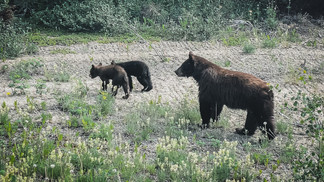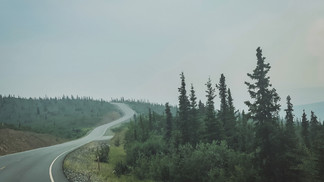In early July I headed out to the Yukon Territory, Canada, with the aim to race in the longest paddle race in the world, the Yukon 1000. For reasons I go into here, it didnt quite work out for us this year when I contracted covid two days before the race start. But once I had recovered, my paddle partner Skip and I were determined to make the most of our time at Earth's Final Frontier....
GETTING THERE
Getting to Whitehorse from the UK is relatively cheap and easy. Westjet fly daily from London Gatwick to Vancouver (around 9hrs), and from there you can connect to Whitehorse (2 hrs) with either Air North (Yukons airline) or Air Canada. We chose Air North, after being told they are very accommodating to those travelling with equipment such as paddles etc, which proved to be the case.

Whitehorse airport is just a couple of kilometres out of town. We pre-booked a taxi to pick us up as we wouldn’t be arriving until late in the evening - its not the kind of airport that has lots going on so we didn't expect to find a bustling taxi rank!
Travel Tip : I put Apple AirTags in all my luggage. I'm able to check that the bags are on the flight with me, and where they are when waiting at the baggage belt. I was even able to tell Lufthansa that they left one of my bags in Frankfurt when I arrived back in Heathrow!
WHITEHORSE
Whitehorse is the capital city of the Yukon Territory - an area twice the size of the United Kingdom, but with a population of only 40,000 - 75% of which live in Whitehorse! In the summer its a bustling city with lots of visitors that come in on coach tours - it is definitely advisable to book a hotel as early as possible before heading out. The Yukon River runs straight through the heart of the city and is a perfect base for exploring the river.
PADDLING THE YUKON
The Yukon River has its source in British Columbia, and runs 2000 miles through Yukon and Alaska before emptying into the Bering Sea.
There are many options available when looking to paddle on the Yukon, ranging from a couple of hours going down stream to multi day expeditions to places like Carmacks and Dawson (700km). We only had a day before we were planning to head north so we decided to paddle from Whitehorse to the Takhini River junction (around 20km), where there was a pull out spot close to the road. We organised a shuttle to collect us and our boards through Up North Adventures. There are a few other places in town that offer shuttle services to various put in’s and pull out’s on the river - just book in advance, don't expect to rock up on the day and find someone twiddling their thumbs waiting for a booking.
The river was flowing high & fast due to the amount of snowmelt and conditions in the spring - it was like joining a conveyor belt of water when we put in on the bank at Whitehorse. Within minutes, and with very little effort we were moving along at 16 km/h!
The flow slowed as the river meandered out of town and we spent time exploring the banks and islands as the river opened up. This part of the river is great for learning to read the river flow, find, enter and leave eddy’s and spot the fast channels. All very valuable skills when paddling on rivers like the Yukon.
We saw our first eagle, perched up high on a tree looking over the river - you could almost feel it’s gaze as it watched us. A few km’s further and our eagle count was now at three. 3 hours later and we were approaching where the Takhini river joins the Yukon, and our pull out point. Sticking close to the left bank, we turned onto the Takhini. Sticking to the left meant we only had a bit of flowing water to deal with before reaching the exit point and our shuttle back to Whitehorse.
HEADING NORTH
The following day we hit the road heading North; car rental is essential if you plan on doing anything other than the Yukon river. Again, book something well in advance of getting to Whitehorse - this is peak season, and like hotels, rental cars are in limited supply if you haven’t sorted something before arriving.

The roads are a mix of tarmac and gravel, and whilst generally in good condition, you need to keep your wits about you as pot holes and cracks appear often, and without warning. Forest fires are also prevalent this time of year - blue skies are replaced with grey smoke and visibility drops. In places the flames can come right up to the road and often roads are closed for days at a time while the services tackle the fires. When there are effectively only two roads that go north, this can cause problems and you need to be ready to adjust plans accordingly.
511yukon.ca is the place to go to check on conditions and closures, but you will need to check this before leaving town as a few kilometres outside of Whitehorse and all mobile reception goes. This is really important to understand - other than in a handful of large villages and towns (which are few and far between), there is NO reception in this vast wilderness. Bear this in mind when it comes to things like relying on your phone for navigation (no signal = no downloading of maps), music (make sure you’ve downloaded your road trip tunes before leaving!) or in the event of an emergency. It is highly recommended that you hire a satellite phone - something that can easily be done before leaving the UK from companies such as G Comm.
We rented a 9575 Extreme - small, rugged and resistant to dust / shock / rain etc. The phones come loaded with 60 minutes of call time on the iridium network - the recommended satellite network for this part of the world.
We also took a SPOT tracker with us. Our GEN 3 unit sent pings every 30 mins using the GPS network and we could share a web link with people at home so they could see where we were. The SPOT tracker also has an SOS button that, once pressed, would start a chain of activity that would ultimately result in someone getting to our location.
Finally, we had both a Garmin 64S GPS unit and our Garmin Fenix 7SS watches so we knew exactly where we were if we needed to pass on coordinates.
Personally I absolutely loved being totally disconnected from the outside world - no social media doom scrolling, no access to news, no distractions. Just miles upon miles of wilderness waiting to be explored.
Being this far from anywhere its also important to take enough food and water with you. I also recommend something like a Lifestraw or purification tabs so you can treat water from rivers and lakes if you run out. You also need to be bear safe; there are more bears than humans in this parts of the world - you don’t want a close encounter. Anything that smells (food, toothpaste, toiletries etc) goes into a bear barrel and take nothing that smells into your tent. Keep your bear spray with you at all times!
CAMPING
You can wild camp, or stop at one of the established campsites you will pass on either of the two main roads. Facilities are in most cases very limited; pit toilets and a water pipe. Sometimes you will be lucky and there will be a shower (we preferred to wash in the rivers and lakes however). The government websites cost $20 CAD a night and you leave the cash in an envelope. These sites are not staffed; it’s done very much on a trust basis. Finally, be prepared to deal with the mosquitos - spray and ideally a head net are the order of the day!
EXPLORING EARTHS FINAL FRONTIER
As we drove up through the Yukon and across the border into Alaska there was no shortage of opportunities to paddle; it seemed there was never a body of water or river that far from the road as we headed towards the Arctic Circle. There was always time to paddle too - the sun hardly sets this far north in July; we would often find ourselves heading out for a paddle at 11pm, or grabbing a beer (or sour toe!) in Dawson at gone midnight, when outside it felt like 2pm.
The lakes were incredibly clear and tranquil, the air is fresh and scenery is breathtaking. Rivers varied from clear waters to silty cloudy water from the volcanic ash at the rivers source. We often questioned whether we were the first people to put a paddle board on the lake, seeing as how remote we were.
After covering nearly 2000 miles, we finished up in Fairbanks, Alaska where we had a couple of days to pass before our flights home. Condor Air fly from Fairbanks to Frankfurt twice a week, and connect on to Heathrow. There are also options to fly to Seattle, and then back to the UK - in hindsight this would have been better and would have given us many more daily options for getting back - Fairbanks offers very little to do.
KIT
We both took our Yster 17’3 x 26 iSUP’s and 3-piece Ocean Specific paddles, making it really easy to pack down into a suitcase suitable for flying. The boards are perfect for expedition / exploring with fantastic glide and plenty of space to carry kit.

We will be heading back to Yukon next Summer to race in the Yukon 1000, and we have plans to start taking paddlers from the UK for guided expeditions soon!















































































































Comments